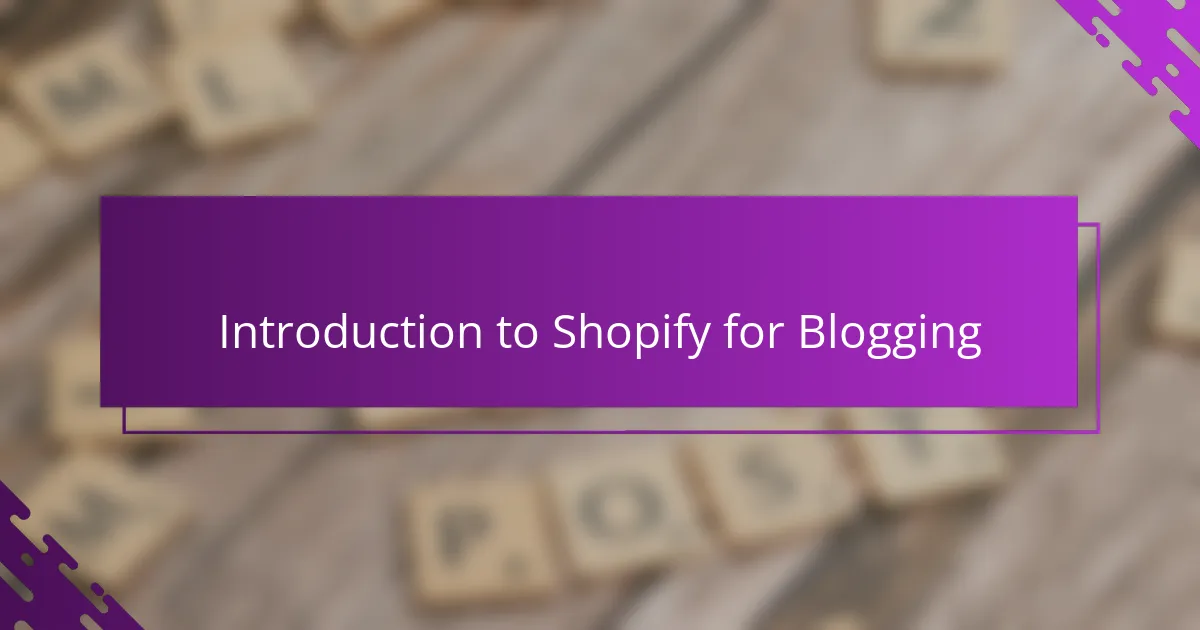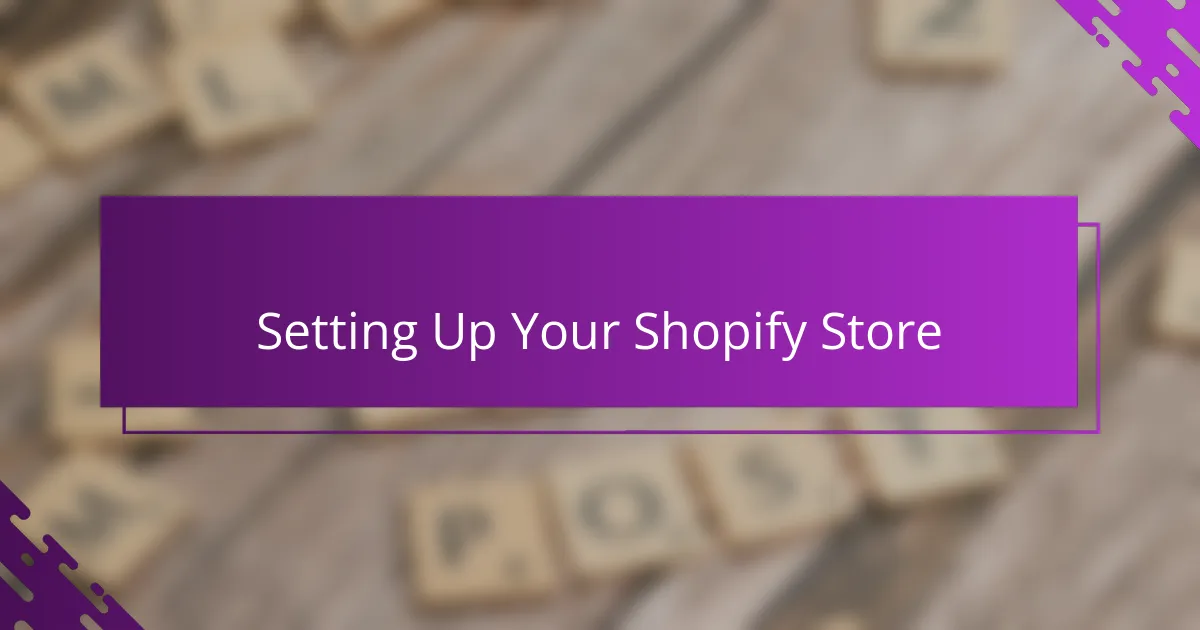Key takeaways
- Brand building involves a clear understanding of values, consistent emotional connections, and knowing your target audience.
- Shopify offers user-friendly tools that enable seamless integration of blogging and commerce, fostering creativity in audience engagement.
- Growing an audience relies on authentic interaction, providing valuable content, and collaborating with others to expand reach.
- Successful sales management focuses on understanding customer behavior and nurturing relationships through personal touches.

Understanding Brand Building Basics
Brand building starts with a clear understanding of who you are and what you stand for. When I first embarked on this journey, defining my brand values wasn’t just a task—it felt like uncovering a part of myself I hadn’t fully explored. Have you ever thought about what truly makes your story unique? That’s where your brand lives.
Creating consistency across every touchpoint is another vital piece of the puzzle. I quickly learned that it’s not just about a logo or a catchy tagline; it’s about the emotions you evoke every time someone interacts with your brand. Think about the last time a brand made you feel something—what stuck with you? That emotional connection is the cornerstone of loyalty.
Finally, understanding your target audience is crucial. Early on, I assumed my product would resonate with everyone, but reality hit differently. Narrowing down who you’re speaking to allows you to craft messages that truly connect, rather than shout into the void. Have you ever tried talking to someone without really knowing what they care about? It’s frustrating, and your brand’s voice deserves better than that.

Introduction to Shopify for Blogging
When I first discovered Shopify, I was surprised at how much more than just an online store it could be. Have you ever thought about turning your blog into a thriving brand? Shopify offers tools that blend content and commerce seamlessly, making that leap feel achievable.
What drew me in was how Shopify simplifies managing a brand’s presence without needing a degree in web design. I remember feeling overwhelmed trying to integrate my blog with my products, but Shopify’s user-friendly setup changed the game. It’s like having a digital partner that handles the technical stuff, so you can focus on storytelling.
And here’s something I didn’t expect—Shopify’s platform encourages creativity in how you connect with your audience. Have you noticed how some blogs feel like personal conversations? Shopify helped me create that vibe while also building a professional edge, turning casual readers into loyal customers.

Setting Up Your Shopify Store
Setting up my Shopify store was surprisingly straightforward, but that initial step felt like standing at the edge of a vast ocean of possibilities. Have you ever felt both excited and overwhelmed when starting something new? That’s exactly how I felt when choosing my store’s theme—it had to reflect my brand’s personality without sacrificing functionality.
I remember spending hours customizing the layout, experimenting with colors and fonts until everything felt just right. It wasn’t about perfection; it was about creating a space that felt authentically mine. Isn’t it amazing how a few clicks can bring your vision to life in such a tangible way?
Adding products was another eye-opener for me. Instead of just listing items, I focused on telling their stories through descriptions and images. That personal touch made me realize: your store isn’t just a digital catalog, it’s an extension of your brand’s soul. How do you want your customers to feel when they browse your products?

Creating Unique Brand Identity
For me, creating a unique brand identity meant digging deep into what made my story different. It’s not enough to look like everyone else; your brand needs a distinct voice that feels genuinely yours. Have you ever noticed how some brands just stick with you? That’s the power of being authentically unique.
Colors, fonts, and logos play a part, but I quickly realized it’s the little details that breathe life into your identity. When I chose my color palette, I wasn’t just picking pretty shades—I was setting a mood, an emotional tone my audience could instantly recognize. What feelings do you want your brand to inspire at first glance?
Crafting that identity also meant being consistent but flexible. I learned to keep my core elements steady, so people knew what to expect, while still allowing room to evolve naturally. Have you ever been drawn to a brand that grows with you instead of staying stuck? That balance keeps things real and relevant.

Strategies for Growing Your Audience
Growing an audience isn’t about shouting louder; it’s about listening more. Early on, I realized that engaging authentically with my community made all the difference—responding to comments, asking questions, and sharing behind-the-scenes moments built trust. Have you ever felt more connected to a brand because it seemed like a real person, not just a business?
I also leaned heavily into content that offered real value, not just promotion. By focusing on helpful tips, stories, and insights related to my niche, I found people naturally started sharing and coming back for more. It made me wonder—are you creating for algorithms or for actual humans?
Lastly, collaboration became a game-changer. Partnering with other bloggers and brands expanded my reach in ways I hadn’t imagined. There’s something powerful about connecting audiences through shared passions. Have you considered how your network could become your net worth?

Managing Sales and Customer Relations
Managing sales on Shopify quickly taught me that it’s not just about numbers—it’s about understanding what makes customers click that “buy” button. When I first saw my sales dashboard, I realized I needed to dive deeper into patterns instead of just celebrating every sale. Have you ever wondered why some products fly off the shelves while others don’t get a second glance?
Customer relations became my real priority after I encountered my first unhappy buyer. At first, handling complaints felt daunting, but I soon saw it as an opportunity to build trust and loyalty. I started replying personally to every message, treating each customer like a friend rather than just a transaction. How do you think you’d feel if a brand reached out to you with genuine care?
Shopify’s tools made it easier to keep these connections alive—from automated thank-you emails to tracking repeat customers. But what mattered most was the personal touch I added, like handwritten notes and surprise discounts. Those small gestures told me that managing sales is about more than just closing deals; it’s about nurturing relationships that last. Have you ever experienced the difference a little kindness makes in your own shopping journey?

Lessons Learned and Tips for Success
One big lesson I learned is that patience is key. Success doesn’t happen overnight, and when I started seeing slow growth, I had to remind myself that every small win counts. Have you ever felt discouraged waiting for results? That feeling is normal, but persistence always pays off.
Another tip I’d share is to stay flexible and open to feedback. I remember a time when I stubbornly stuck to an idea that wasn’t resonating, and it cost me valuable connections. Once I shifted gears based on what my audience wanted, everything started clicking. How often do we really listen to the people we want to reach?
Lastly, don’t underestimate the power of storytelling. What made my brand relatable wasn’t just the products, but the stories behind them. Sharing my journey—the struggles and victories—turned casual visitors into loyal supporters. Have you considered what story only you can tell? That’s where real magic happens.
